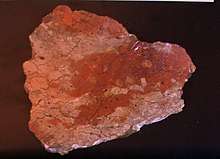Puchezh-Katunki crater
Puchezh-Katunki is a meteor crater located in the Nizhny Novgorod Oblast of the Volga Federal District, Russia. It is 80 km (50 mi) in diameter and is estimated to be 167 ± 3 million years old, placing it in the Middle Jurassic. The crater is not exposed to the surface, but appears as variation in the vegetation. The Earth Impact Database lists a rim-to-rim diameter of 40 kilometres (25 mi). [1]
 Landsat image of Puchezh-Katunki crater | |
| Impact crater/structure | |
|---|---|
| Confidence | Confirmed |
| Diameter | 40 km (25 mi) (rim-to-rim) 80 km (50 mi) (including ring terrace) |
| Age | 167 ± 3 Ma Middle Jurassic |
| Exposed | No |
| Drilled | Yes |
| Location | |
| Coordinates | 56°58′N 43°43′E |
| Country | Russia |
| Province | Nizhny Novgorod Oblast |
 Location of the crater in Russia | |
Description

The central dome, ring depression, and ring terrace of the 80 km (50 mi) wide impact structure are nearly completely buried under Neogene and Quaternary sediments, with the only exposed impactites found on the banks of the Volga River. [2]
One of the six largest known Phanerozoic impact craters, the Puchezh-Katunki crater is the only one not considered as a factor in a biotic extinction event. There is no known significant extinction in the Middle Jurassic, but there are clues suggesting the impact may have occurred coeval with the end-Triassic or Early Jurassic extinction.[2]
See also
References
- "Puchezh-Katunki". Earth Impact Database. Planetary and Space Science Centre University of New Brunswick Fredericton.
- Pálfy, József (2004). "Did the Puchezh-Katunki Impact Trigger an Extinction?". Hungarian Natural History Museum.

